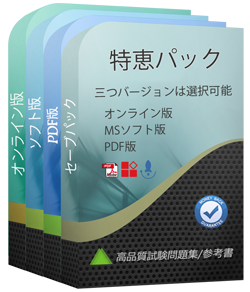Tech4Examはどんな試験参考書を提供していますか?
テストエンジン:NCA-GENM試験試験エンジンは、あなた自身のデバイスにダウンロードして運行できます。インタラクティブでシミュレートされた環境でテストを行います。
PDF(テストエンジンのコピー):内容はテストエンジンと同じで、印刷をサポートしています。
あなたのテストエンジンはどのように実行しますか?
あなたのPCにダウンロードしてインストールすると、NVIDIA NCA-GENMテスト問題を練習し、'練習試験'と '仮想試験'2つの異なるオプションを使用してあなたの質問と回答を確認することができます。
仮想試験 - 時間制限付きに試験問題で自分自身をテストします。
練習試験 - 試験問題を1つ1つレビューし、正解をビューします。
返金するポリシーはありますか? 失敗した場合、どうすれば返金できますか?
はい。弊社はあなたが我々の練習問題を使用して試験に合格しないと全額返金を保証します。返金プロセスは非常に簡単です:購入日から60日以内に不合格成績書を弊社に送っていいです。弊社は成績書を確認した後で、返金を行います。お金は7日以内に支払い口座に戻ります。
あなたはNCA-GENM試験参考書の更新をどのぐらいでリリースしていますか?
すべての試験参考書は常に更新されますが、固定日付には更新されません。弊社の専門チームは、試験のアップデートに十分の注意を払い、彼らは常にそれに応じてNCA-GENM試験内容をアップグレードします。
更新されたNCA-GENM試験参考書を得ることができ、取得方法?
はい、購入後に1年間の無料アップデートを享受できます。更新があれば、私たちのシステムは更新されたNCA-GENM試験参考書をあなたのメールボックスに自動的に送ります。
購入後、どれくらいNCA-GENM試験参考書を入手できますか?
あなたは5-10分以内にNVIDIA NCA-GENM試験参考書を付くメールを受信します。そして即時ダウンロードして勉強します。購入後にNCA-GENM試験参考書を入手しないなら、すぐにメールでお問い合わせください。
NCA-GENMテストエンジンはどのシステムに適用しますか?
オンラインテストエンジンは、WEBブラウザをベースとしたソフトウェアなので、Windows / Mac / Android / iOSなどをサポートできます。どんな電設備でも使用でき、自己ペースで練習できます。オンラインテストエンジンはオフラインの練習をサポートしていますが、前提条件は初めてインターネットで実行することです。
ソフトテストエンジンは、Java環境で運行するWindowsシステムに適用して、複数のコンピュータにインストールすることができます。
PDF版は、Adobe ReaderやFoxit Reader、Google Docsなどの読書ツールに読むことができます。
割引はありますか?
我々社は顧客にいくつかの割引を提供します。 特恵には制限はありません。 弊社のサイトで定期的にチェックしてクーポンを入手することができます。
NVIDIA Generative AI Multimodal 認定 NCA-GENM 試験問題:
1. You are tasked with building a multimodal generative A1 model that takes both image and text as input to generate a coherent video. Which of the following architectures is MOST suitable for this task, considering the need to fuse information from different modalities and generate sequential data?
A) A Support Vector Machine (SVM) classifier trained to predict the next frame based on image and text features.
B) A Generative Adversarial Network (GAN) trained solely on image data and later fine-tuned with text embeddings.
C) A Transformer-based architecture with separate encoders for image and text, followed by a decoder that generates video frames.
D) A simple recurrent neural network (RNN) that concatenates image feature vectors and text embeddings as input at each time step.
E) A standard Convolutional Neural Network (CNN) followed by a fully connected layer.
2. You're developing a multimodal A1 system that takes image data, text descriptions, and user interaction data (clicks, dwell time) to generate personalized product recommendations. To effectively combine these modalities and capture complex relationships, which model architecture would be most suitable?
A) A simple linear regression model.
B) A decision tree-based model.
C) A Naive Bayes classifier.
D) A deep learning architecture incorporating attention mechanisms and cross-modal fusion layers, with separate embedding layers for each modality, followed by a shared representation layer for joint learning and prediction.
E) A k-nearest neighbors (KNN) algorithm.
3. Consider a scenario where you're integrating CLIP with a generative model to create images from text prompts. Which of the following best describes the primary role of CLIP in this process?
A) To act as a discriminator in a GAN setup.
B) To optimize the hyperparameters of the generative model.
C) To decode generated images back into text descriptions.
D) To directly generate images based on text prompts.
E) To encode text prompts into a vector representation that guides the image generation process.
4. You are tasked with evaluating a text-to-video generation model. Which of the following metrics would be MOST appropriate for assessing the temporal coherence and smoothness of the generated videos?
A) BLEU score
B) Frchet Inception Distance (FID)
C) Inception Score (IS)
D) Learned Perceptual Image Patch Similarity (LPIPS)
E) Frchet Video Distance (FVD)
5. You're building a multimodal model that takes images and text as input. You notice that your model is heavily biased towards the text modality, essentially ignoring the visual input. Which of the following strategies could you employ to address this modality imbalance? (Select TWO)
A) Implement a gating mechanism that dynamically adjusts the contribution of each modality based on the input.
B) Use a modality-specific loss function, weighting the loss from the visual modality more heavily.
C) Remove the text modality entirely.
D) Increase the learning rate for the text encoder.
E) Reduce the size of the visual encoder.
質問と回答:
| 質問 # 1 正解: C | 質問 # 2 正解: D | 質問 # 3 正解: E | 質問 # 4 正解: E | 質問 # 5 正解: A、B |


 弊社は製品に自信を持っており、面倒な製品を提供していません。
弊社は製品に自信を持っており、面倒な製品を提供していません。



 -海老**
-海老**

